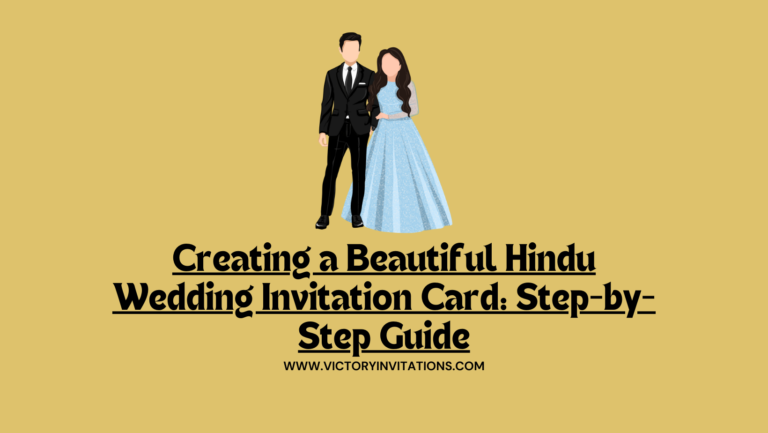Creating a beautiful Hindu wedding invitation card involves balancing tradition, aesthetics, and modern personalization to make a memorable first impression for your wedding. Here’s a step-by-step guide to designing an invitation that captures the essence of a Hindu wedding:
Step 1: Choose the Right Theme
Start by selecting a theme that reflects the cultural and religious significance of your wedding. Themes can vary widely, from traditional to modern:
- Traditional Themes: Opt for motifs like the lotus, mandala, peacock feathers, or Lord Ganesha symbols, all of which hold deep cultural meaning.
- Modern or Minimalistic Themes: You can keep it simple with elegant gold accents, watercolor illustrations, or a combination of soft pastel colors.
- Seasonal Themes: Incorporate seasonal elements, such as floral motifs for a spring wedding or bold, warm colors for a winter ceremony.
Step 2: Choose Your Color Scheme
Color plays a vital role in Hindu wedding invitations, as it symbolizes various aspects of the ceremony. Some popular color choices are:
- Red and Gold: Traditional colors symbolizing prosperity, happiness, and good fortune.
- Bright Yellow and Maroon: For a more traditional and festive look.
- Pastels and Ivory: For a modern and sophisticated vibe, pastels or neutral shades add a touch of elegance.
- Royal Blue and Emerald Green: Rich and regal tones are perfect for luxury-themed invitations.
Step 3: Select the Right Paper or Digital Format
Choose a material or format that fits your theme and budget:
- High-Quality Paper: Handmade paper, velvet-finish, or matte cardstock are excellent choices for a luxurious touch.
- Digital Invitations: Digital cards are eco-friendly and can include interactive features like animations or videos. They also allow for instant sharing.
Step 4: Design the Layout
The layout should be clear, organized, and easy to read:
- Cover Design: The front page should feature your chosen theme, often with a traditional symbol like a lotus or Ganesh motif. Keep it minimalistic yet eye-catching.
- Inside Layout: Use a two-column layout for traditional wording on one side and a modern twist or graphical element on the other.
- Typography: Choose elegant fonts that are legible. Consider using Sanskrit or Hindi calligraphy for names and traditional verses.
Step 5: Use Traditional Elements
Incorporating traditional elements is essential to capturing the cultural richness of a Hindu wedding:
- Sacred Symbols: Consider including sacred symbols such as Om, Swastik, or Kalash, which add authenticity and tradition.
- Religious Mantras: Use traditional blessings like “Shree Ganeshaya Namah” or “Jai Shree Krishna” at the top of the card to invoke blessings.
- Traditional Borders: Utilize decorative borders like paisley, floral patterns, or traditional block prints around the edges.
Step 6: Create a Personal Touch
Personalization makes the invitation more memorable:
- Photo of the Couple: Consider including a subtle photo of the couple or an illustration that represents the two families coming together.
- Custom Monograms: A personalized monogram with the couple’s initials can be an elegant addition to the design.
- Poetry or Quotes: Include a romantic quote, a few lines of traditional poetry, or even Sanskrit shlokas to set the tone.
Step 7: Include All Essential Information
Ensure that your invitation is informative and clear:
- Names: Clearly state the names of the bride, groom, and both families.
- Date and Time: Mention the exact date and time of all wedding events, including pre-wedding ceremonies like Haldi, Mehendi, and Sangeet.
- Venue: Provide the complete address of each venue, along with a map or directions if needed.
- Dress Code: If there’s a specific dress code, make sure to mention it in a clear and concise manner.
- RSVP Details: Include a way for guests to confirm their attendance, whether it’s a phone number, email, or a QR code.
Step 8: Add Special Features
Adding special elements can make your invitation stand out:
- Foil Stamping: Gold or silver foil stamping adds a touch of luxury to names or headings.
- Embossed or Laser-Cut Details: For a 3D effect, consider embossed patterns or intricate laser-cut designs that add elegance.
- Caricatures or Illustrations: Personalized caricatures of the bride and groom can add a fun element to your invitation.
- Bilingual Text: Consider including the text in English and Hindi (or another regional language) to make it accessible to all guests.
Step 9: Proofread and Finalize
Proofreading is crucial to avoid any errors:
- Check for spelling mistakes in names, dates, and addresses.
- Make sure the invitation maintains clarity in both wording and design.
- Confirm that all details are accurate, including RSVP contacts and event times.
Step 10: Print or Send Digitally
Once everything is finalized, decide how to deliver the invitations:
- Physical Printing: Choose a high-quality printer that can handle specialty finishes like embossing, foil, or velvet touch.
- Digital Sending: Use a reliable digital invitation service if you opt for e-cards. Digital invites can be sent via email, WhatsApp, or social media.
Conclusion
Creating a beautiful Hindu wedding invitation card is a mix of tradition, personalization, and aesthetics. From choosing the theme and colors to incorporating traditional symbols and finalizing the layout, each step ensures that your card reflects the cultural richness and joy of your special day. If you need expert guidance in designing a unique and customized Hindu wedding invitation, feel free to contact Victory Invitations through WhatsApp for personalized assistance and a seamless invitation creation experience!
